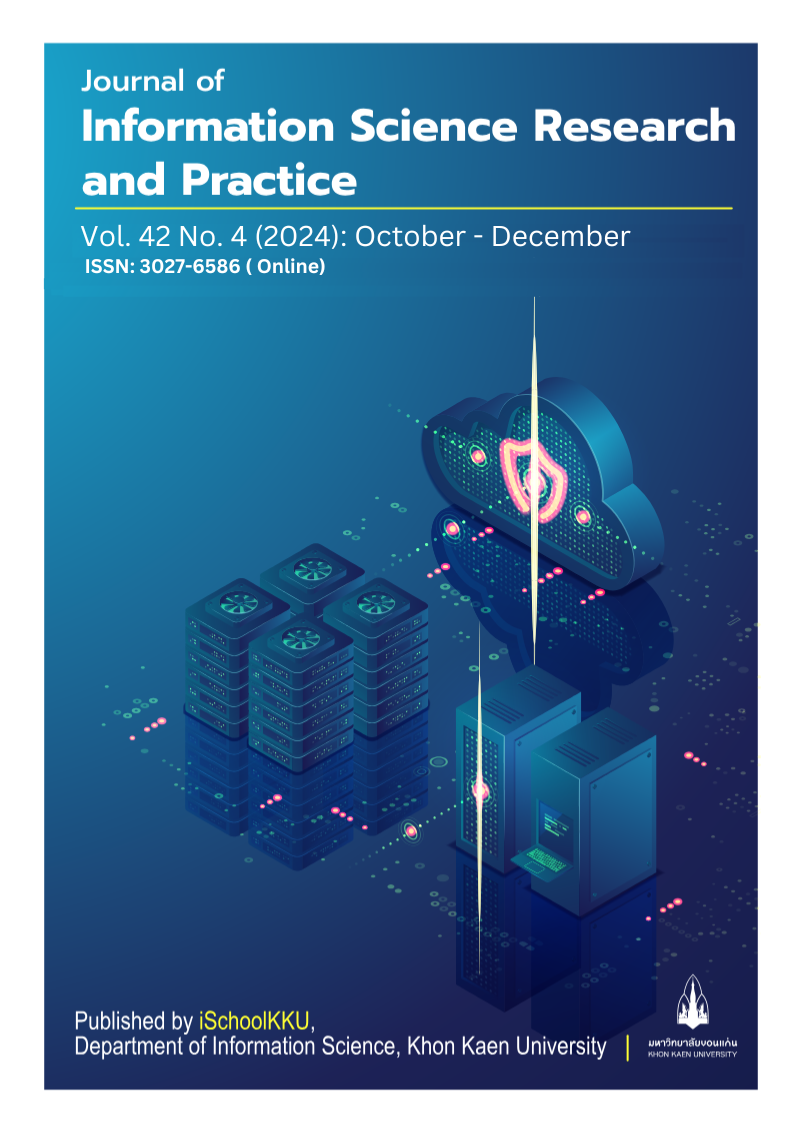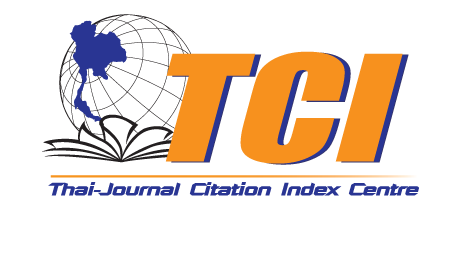A การวิเคราะห์เนื้อหาเรื่องแมลงกินได้ในสื่อออนไลน์
DOI:
https://doi.org/10.14456/jiskku.2024.32คำสำคัญ:
การวิเคราะห์เนื้อหา , ความผิดปกติของข้อมูลข่าวสาร , ข่าวปลอม , อาหารแห่งอนาคต , แมลงกินได้ , โปรตีนทางเลือก , ความมั่นคงทางอาหาร , จิ้งหรีด , ตั๊กแตน, สื่อออนไลน์บทคัดย่อ
วัตถุประสงค์: ศึกษาเนื้อหาเกี่ยวกับแมลงกินได้และวิเคราะห์ความผิดปกติของข้อมูลในสื่อออนไลน์
วิธีการศึกษา: ใช้ระเบียบวิธีวิจัยเชิงคุณภาพ ด้วยการวิเคราะห์เนื้อหา รวบรวมข้อมูลจากสื่อออนไลน์ 3 แพลตฟอร์ม ได้แก่ เฟซบุ๊ก ยูทูบ และติ๊กต็อก โดยใช้คำค้นหา #จิ้งหรีด #ตั๊กแตน #อาหารแห่งอนาคต และ #แมลงกินได้ ระหว่างวันที่ 1 พฤษภาคม พ.ศ.2564 ถึง 30 เมษายน พ.ศ.2566 วิเคราะห์ด้วยตารางแจกแจงความถี่และแนวคิดเรื่องแมลงกินได้ควบคู่กับแนวคิดความผิดปกติของข้อมูลข่าวสาร
ข้อค้นพบ: จากข้อมูล 102 โพสต์ พบว่าเนื้อหาเชิงบวกเกี่ยวกับการตลาดและโอกาสทางธุรกิจเผยแพร่บนยูทูบโดยสำนักข่าวมากที่สุด รองลงมาคือเนื้อหาเชิงลบเกี่ยวกับการพบพยาธิในแมลง โดยส่วนใหญ่เป็นเนื้อหาต้นน้ำของอุตสาหกรรมแมลงกินได้ ความผิดปกติของข้อมูลข่าวสารพบในรูปแบบข้อมูลผิดและข้อมูลบิดเบือนใกล้เคียงกัน ความคิดเห็นที่มีส่วนร่วมมากมักมีการเสียดสี ล้อเลียน และใช้ถ้อยคำแสลงหรืออวัจนภาษาเพื่อหลีกเลี่ยงการควบคุม ยูทูบเป็นช่องทางหลักของเนื้อหาที่มีความผิดปกติของข้อมูลข่าวสาร ส่วนเฟซบุ๊กมีความคิดเห็นที่มีส่วนร่วมมากที่สุด
การประยุกต์ใช้จากการศึกษานี้: ผลการศึกษาสามารถนำไปใช้เป็นข้อมูลพื้นฐานสำหรับการวางแผนสื่อสารเกี่ยวกับแมลงกินได้ให้ถูกต้อง รวมถึงการจัดการความผิดปกติของข้อมูลข่าวสาร และสะท้อนบทบาทของสำนักข่าวออนไลน์ในการเผยแพร่ข้อมูลดังกล่าว
Downloads
References
Abdullahi, N., Igwe, E. C., Dandago, M. A., & Yunusa, A. K. (2021). Consumption of edible-insects: the challenges and the prospects. Food ScienTech Journal, 3(1), 1. https://doi.org/10.33512/fsj.v3i1.10468
Association for Progressive Communications. (2021). Disinformation and freedom of expression. Switzerland: Office of the United Nations High Commissioner for Human Rights.
Ayieko, I. A., Onyango, M., Ngadze, R. T., & Ayieko, M. A. (2021). Edible insects as new food frontier in the hospitality industry. Frontiers in Sustainable Food Systems, 5, 693990. https://doi.org/10.3389/fsufs.2021.693990
Bai, Y., Yao, Z., & Dou, Y.-F. (2015). Effect of social commerce factors on user purchase behavior: An empirical investigation from renren.com. International Journal of Information Management, 35(5), 538–550. https://doi.org/10.1016/j.ijinfomgt.2015.04.011
Baker, M. A., Shin, J. T., & Kim, Y. W. (2016). An exploration and investigation of edible insect consumption: The impacts of image and description on risk perceptions and purchase intent. Psychology & Marketing, 33(2), 94–112. https://doi.org/10.1002/mar.20847
Brunner, T. A., & Nuttavuthisit, K. (2019). A consumer-oriented segmentation study on edible insects in Switzerland and Thailand. British Food Journal, 122(2), 482–488. https://doi.org/10.1108/bfj-08-2018-0526
Dataxet. (2024). Thailand media landscape 2024. Retrieved from Thailand Media Landscape website: https://www.dataxet.co/media-landscape/2024-th
Dicke, M., Eilenberg J., Salles J.F., Jensen A.B., Lecocq A., Pijlman G.P., van Loon J.J.A. and van Oers M.M. (2020). Edible insects unlikely to contribute to transmission of coronavirus SARS-CoV-2. Journal of Insects as Food and Feed, 6(4), 333–339. https://doi.org/10.3920/jiff2020.0039
Domenico, G. D., Sit, J., Ishizaka, A., & Nunan, D. (2021). Fake news, social media and marketing: A systematic review. Journal of Business Research, 124(1), 329–341. https://doi.org/10.1016/j.jbusres.2020.11.037
Dougherty, D. S., Schraedley, M. A., Gist-Mackey, A. N., & Wickert, J. (2018). A Photovoice study of food (in)security, unemployment, and the discursive-material dialectic. Communication Monographs, 85(4), 443–466. https://doi.org/10.1080/03637751.2018.1500700
Duffus, N. E., Christie, C. R., & Morimoto, J. (2021). Insect cultural services: How insects have changed our lives and how can we do better for them. Insects, 12(5), 377. https://doi.org/10.3390/insects12050377
Food And Agriculture Organization Of The United Nations. (2013). Edible insects: Future prospects for food and feed security. Rome, Italy: Food And Agriculture Organization Of The United Nations, Beaconsfield, Quebec.
Halloran, A., Flore, R., Vantomme, P., & Roos, N. (Eds.). (2018). Edible insects in sustainable food systems. Cham: Springer International Publishing. https://doi.org/10.1007/978-3-319-74011-9
Jenkins, H. (2006). Convergence culture: Where old and new media collide. New York: New York University Press.
Junges, J. R., do Canto, N. R., & de Barcellos, M. D. (2021). Not as bad as i thought: Consumers’ positive attitudes toward innovative insect-based foods. Frontiers in Nutrition, 8, 631934. https://doi.org/10.3389/fnut.2021.631934
Kagan, N. (2014). How to create viral content: 10 insights from 100 million articles - Noah Kagan. Retrieved from https://noahkagan.com/why-content-goes-viral-what-analyzing-100-millions-articles-taught-us/?hvid=41eiUq
Kandel, N. (2020). Information disorder syndrome and its management. Journal of Nepal Medical Association, 58(224), 280–285. https://doi.org/10.31729/jnma.4968
Kauppi, S.-M., Pettersen, I. N., & Boks, C. (2019). Consumer acceptance of edible insects and design interventions as adoption strategy. International Journal of Food Design, 4(1), 39–62. https://doi.org/10.1386/ijfd.4.1.39_1
Kemp, S. (2024). Digital 2024: Thailand. Retrieved from https://datareportal.com/reports/digital-2024-thailand
Krippendorff, K. (2018). Content analysis: An introduction to its methodology (4th ed.). Los Angeles, Calif. Etc.: Sage.
Legendre, T. S., & Baker, M. A. (2021). The gateway bug to edible insect consumption: interactions between message framing, celebrity endorsement and online social support. International Journal of Contemporary Hospitality Management, 33(5), 1810–1829. https://doi.org/10.1108/ijchm-08-2020-0855
Looy, H., Dunkel, F. V., & Wood, J. R. (2013). How then shall we eat? Insect-eating attitudes and sustainable foodways. Agriculture and Human Values, 31(1), 131–141. https://doi.org/10.1007/s10460-013-9450-x
Marberg, A., van Kranenburg, H., & Korzilius, H. (2017). The big bug: The legitimation of the edible insect sector in the Netherlands. Food Policy, 71, 111–123. https://doi.org/10.1016/j.foodpol.2017.07.008
Muhammed , S. T., & Mathew, S. K. (2022). The disaster of misinformation: A review of research in social media. International Journal of Data Science and Analytics, 13(4), 271–285. https://doi.org/10.1007/s41060-022-00311-6
Nadeem, W., Andreini, D., Salo, J., & Laukkanen, T. (2015). Engaging consumers online through websites and social media: A gender study of Italian Generation Y clothing consumers. International Journal of Information Management, 35(4), 432–442. https://doi.org/10.1016/j.ijinfomgt.2015.04.008
Patchimnan, M., Phankaew, B., & Inson, C. (2022). Integrated marketing communication exposure, attitude, decision-making process and purchasing behavior. International Academy of Global Business and Trade, 18(4), 169–181. https://doi.org/10.20294/jgbt.2022.18.4.169
Ponce-Reyes, R. & Lessard B.D. (2021). Edible Insects - A roadmap for the strategic growth of an emerging Australian industry. Canberra: CSIRO.
Rodríguez-Fernándezr, L. (2019). Disinformation and organisational communication: A study of the impact of fake news. Revista Latina de Comunicación Social, 74, 1714–1728. https://doi.org/10.4185/rlcs-2019-1406en
Schraedley, M.K., Bean H., Dempsey S.E., Dutta M.J., Hunt K.P., ORCID Icon, Ivancic S.R., LeGreco M., Okamoto K. & Sellnow T. (2020). Food (in)security communication: a Journal of Applied Communication Research forum addressing current challenges and future possibilities. Journal of Applied Communication Research, 48(2), 166–185. https://doi.org/10.1080/00909882.2020.1735648
Sogari, G., Liu, A., & Li, J. (2019). Understanding edible insects as food in western and eastern societies. Environmental, Health, and Business Opportunities in the New Meat Alternatives Market, 166–181. https://doi.org/10.4018/978-1-5225-7350-0.ch009
Sotanasathien, S. (2012). Principles and theories of social science research. (In Thai). Bangkok. Rabieng-Thong Printing.
Stockholm Environment Institute. (2020). SEI Annual Report 2019. Stockholm: SEI.
Taddeo, G., de-Frutos-Torres, B., & Alvarado, M.-C. (2022). Creators and spectators facing online information disorder. Effects of digital content production on information skills. Comunicar, 30(72). https://doi.org/10.3916/c72-2022-01
Verneau, F., La Barbera, F., Kolle, S., Amato, M., Del Giudice, T., & Grunert, K. (2016). The effect of communication and implicit associations on consuming insects: An experiment in Denmark and Italy. Appetite, 106, 30–36. https://doi.org/10.1016/j.appet.2016.02.006
Yang, J., & Luttrell, R. (2022). Digital misinformation & disinformation: The global war of words. The Emerald Handbook of Computer-Mediated Communication and Social Media, 511–529. https://doi.org/10.1108/978-1-80071-597-420221030





